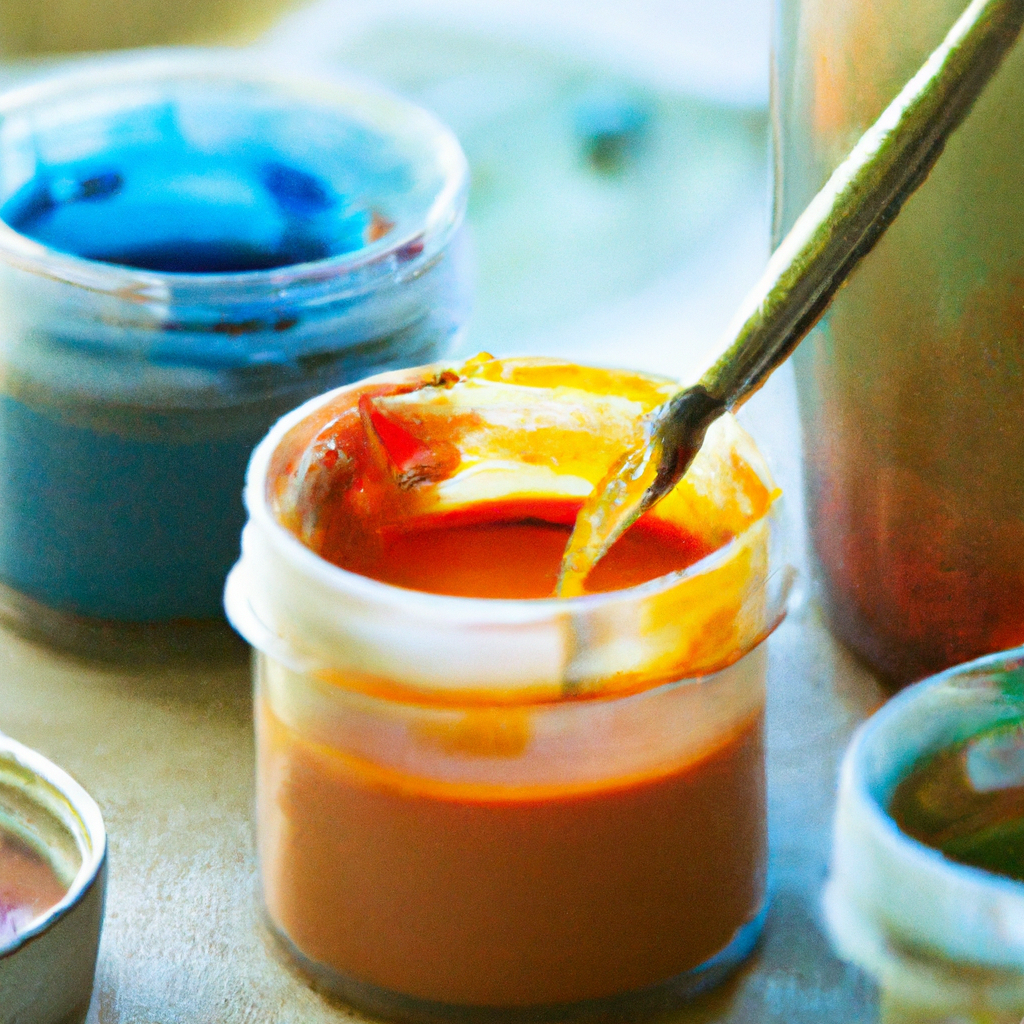Have you accidentally gotten acrylic paint on your favorite pair of shoes? Don’t worry! This article will guide you through the process of removing acrylic paint from your shoes without the use of acetone. Whether you’re a beginner or an experienced artist, we’ve got you covered with simple and effective methods to restore your shoes back to their original glory. Say goodbye to stubborn paint stains and hello to clean and pristine shoes!

Materials You’ll Need
To successfully remove acrylic paint from your shoes without using acetone, you’ll need a few simple materials. Here’s a list of what you’ll need:
- Soap and water: Mild soap mixed with warm water will be used to clean the shoes.
- Toothbrush or soft-bristle brush: This will help scrub and loosen the paint.
- White vinegar: Vinegar is effective in breaking down acrylic paint.
- Rubbing alcohol: Alcohol can also dissolve acrylic paint.
- Olive oil or vegetable oil: These oils will help soften the paint for easier removal.
- Nail polish remover (non-acetone): This will be used as an alternative to acetone for stubborn paint.
- Cotton balls or cotton swabs: These will be used to apply the cleaning agents.
- Clean cloth or paper towels: You’ll need these to wipe away the paint and clean the shoes.
- Gloves (optional): If you prefer to protect your hands, gloves are recommended.
- Protective eyewear (optional): To keep your eyes safe from any splatters, protective eyewear is optional but recommended.
Preparation
Before diving into the paint removal process, a few steps need to be taken to ensure your safety and the best possible outcome. Here’s what you should do to prepare:
- Put on gloves and protective eyewear (optional): While this step is not essential, it can provide an extra layer of protection.
- Move to a well-ventilated area: Working in a well-ventilated space will prevent the buildup of fumes from the cleaning agents.
- Wipe off any excess wet paint: Use a clean cloth or paper towels to wipe away any excess wet paint. This will make the removal process easier.
- Allow the paint to dry completely: It’s essential to let the paint on your shoes dry completely before attempting to remove it. This will prevent smudging and ensure better removal results.
1. Soap and Water Method
The soap and water method is a simple and gentle approach to removing acrylic paint from shoes. Here’s how you can do it:
- Mix warm water and mild soap in a bowl or basin: Fill a bowl or basin with warm water and add a small amount of mild soap. Mix them together to create a soapy solution.
- Dip a toothbrush or soft-bristle brush into the soapy water: Take a toothbrush or soft-bristle brush and dip it into the soapy solution, allowing the bristles to soak up the water.
- Gently scrub the painted area in circular motions: Using the toothbrush or brush, gently scrub the painted area in circular motions. Apply light pressure to avoid damaging the shoe material.
- Continue scrubbing until the paint starts to loosen: Keep scrubbing the area until you begin to see the paint loosen from the shoe’s surface.
- Rinse the shoe with clean water and pat dry with a clean cloth: Once the paint has loosened, rinse the shoe with clean water to remove the soapy residue. Use a clean cloth to pat the shoe dry.
2. White Vinegar Method
White vinegar is known for its cleaning properties and can be effective in removing acrylic paint. Here’s how to use white vinegar to remove paint from your shoes:
- Create a mixture of equal parts white vinegar and water: In a bowl or container, mix equal parts white vinegar and water to create a vinegar solution.
- Dampen a cloth or sponge with the vinegar solution: Take a cloth or sponge, and dampen it with the vinegar solution. Make sure it is not dripping wet.
- Blot the painted area with the vinegar-soaked cloth or sponge: Gently blot the painted area on your shoes with the vinegar-soaked cloth or sponge. Allow the vinegar to penetrate the paint for a few minutes.
- Scrub the area with a toothbrush or soft-bristle brush: Using a toothbrush or soft-bristle brush, scrub the area in circular motions. The vinegar will help break down the paint.
- Rinse the shoe with clean water and pat dry: After scrubbing, rinse the shoe with clean water to remove any vinegar residue. Pat the shoe dry with a clean cloth.

3. Rubbing Alcohol Method
Rubbing alcohol is another effective option for acrylic paint removal. Here’s how you can use it:
- Moisten a cotton ball or cotton swab with rubbing alcohol: Take a cotton ball or cotton swab and moisten it with rubbing alcohol. Make sure it is not too saturated.
- Dab the alcohol-soaked cotton ball or swab onto the paint: Gently dab the alcohol-soaked cotton ball or swab onto the painted area of your shoes. Allow the alcohol to sit on the paint for a few minutes.
- Gently rub the area with a clean cloth or toothbrush: Using a clean cloth or toothbrush, gently rub the area in circular motions. The alcohol will help dissolve the paint.
- Repeat the process until the paint is removed: If necessary, repeat the process until all the paint is removed. Use a fresh cotton ball or swab with each application.
- Wipe away any residual alcohol with a clean cloth: After removing the paint, wipe away any residual alcohol with a clean cloth.
4. Olive Oil or Vegetable Oil Method
Olive oil or vegetable oil can be used as a natural and gentle method for paint removal. Here’s how to do it:
- Apply a small amount of olive oil or vegetable oil to the painted area: Take a small amount of olive oil or vegetable oil and apply it directly to the painted area on your shoes.
- Allow the oil to penetrate the paint for a few minutes: Let the oil sit on the paint for a few minutes. This will help soften the paint for easier removal.
- Scrub the area with a toothbrush or soft-bristle brush: Using a toothbrush or soft-bristle brush, scrub the painted area in circular motions. The oil will help loosen the paint.
- Wipe off the oil and paint with a clean cloth: Once the paint has loosened, wipe off the oil and paint with a clean cloth.
- Repeat the process if needed: If there is still paint remaining, repeat the process until the desired result is achieved.

5. Nail Polish Remover (Non-acetone) Method
Non-acetone nail polish remover can be an effective alternative to acetone for removing acrylic paint. Here’s how to use it:
- Soak a cotton ball or cotton swab with non-acetone nail polish remover: Take a cotton ball or cotton swab and saturate it with non-acetone nail polish remover.
- Gently rub the paint with the nail polish remover-soaked cotton ball or swab: Gently rub the painted area on your shoes with the nail polish remover-soaked cotton ball or swab.
- Continue rubbing until the paint starts to dissolve: Keep rubbing the area until the paint starts to dissolve. The non-acetone nail polish remover will break down the paint.
- Wipe away the paint and nail polish remover with a clean cloth: Once the paint has dissolved, wipe away the paint and nail polish remover with a clean cloth.
- Rinse the shoe with water and pat dry: Finish by rinsing the shoe with water to remove any residue and patting it dry with a clean cloth.
6. Stubborn Paint Removal
If the paint on your shoes is stubborn and not easily removed by the previous methods, don’t worry. Here’s what you can do:
- Repeat any of the above methods if the paint is stubborn: Go back to any of the previous methods that you found to be the most effective and repeat the process on the stubborn paint.
- Scrape off any remaining paint gently using a plastic scraper or credit card: If there is still paint remaining, use a plastic scraper or credit card to gently scrape off the remaining paint. Be careful not to apply too much pressure to avoid damaging the shoe.
- Use a toothbrush or soft-bristle brush with a small amount of rubbing alcohol: Moisten a toothbrush or soft-bristle brush with a small amount of rubbing alcohol. Scrub the remaining paint until it loosens.
- Wipe away the paint and alcohol with a clean cloth: Once the paint has loosened, wipe away the paint and alcohol residue with a clean cloth.

7. Cleaning and Finishing
After successfully removing the paint from your shoes, it’s important to clean and finish the shoes properly. Here’s what you need to do:
- Wash the shoe with mild soap and water to remove any residue: Use mild soap and water to wash the shoe, ensuring all residue from the cleaning agents is removed.
- Rinse thoroughly and pat dry with a clean cloth: Rinse the shoe thoroughly with clean water to remove any soap residue. Pat the shoe dry with a clean cloth.
- Allow the shoe to air dry completely: Let the shoe air dry completely before moving on to the next step.
- Apply a small amount of leather conditioner or shoe polish to restore shine and moisture (if applicable): If your shoes are made of leather or require conditioning, apply a small amount of leather conditioner or shoe polish to restore shine and moisture.
- Buff the shoe using a clean cloth for a polished finish: Use a clean cloth to buff the shoe, giving it a polished and finished look.
8. Prevention Tips
To avoid having to deal with paint removal in the future, it’s helpful to follow these prevention tips:
- Cover your shoes with plastic wrap or wax paper when painting: If you anticipate painting projects, protect your shoes by covering them with plastic wrap or wax paper.
- Avoid wearing your favorite shoes during painting projects: Choose an old pair of shoes or protective shoe covers to wear during painting projects to prevent any accidental paint splatters.
- Clean any spills or splatters immediately to prevent paint from drying: If you accidentally spill or splatter paint on your shoes, clean it up immediately to prevent the paint from drying and becoming difficult to remove.
- Use protective shoe covers or old shoes for messy projects: When working on messy projects, consider using plastic shoe covers or an old pair of shoes specifically designated for such tasks.
- Keep nail polish remover (non-acetone) or rubbing alcohol handy for quick paint removal: Store non-acetone nail polish remover or rubbing alcohol in a convenient location to quickly remove any paint mishaps.




